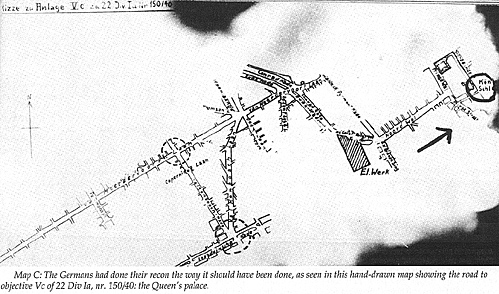German Plans
After Poland, France needed to be crushed as fast as possible. Therefore, the initial date for an attack was set as 11 November 1939. However, bad weather and unforeseen difficulties forced the Germans to postpone the attack numerous times. Eventually it became May 10, 1940.
For the assault on The Netherlands, the Germans fielded the 18th Army, elements of 6th Army and an airlanding corps. The 18th Army consisted of 7 regular army divisions, I armored division, the SS Liebstandarte "Adolf Hitler" and an SS "Verffigungsdivision."
In complete secrecy, Germany had built 2 complete divisions of airborne troops. The 7th Fliegerdivision (paradivision) could be airdropped, while the 22nd Luftlande Division (airlanding division) had to be airlifted to the battle zone. Both units consisted of heavily armed elite assault troops.
From experience, the Germans learned that airlanding troops could best be used in close co-operation with paratroops and vice versa. Therefore, both divisions traded troops. Above the Dutch battlefield they could count on the Luftwaffe for support. For this assignment there were 980 airplanes available: 430 transport planes, 250 fighters and over 300 bombers.
The 18th Army with elements of 6th Army had to invade the Netherlands from the east. In order to clear a path into "Fortress Holland," the 7th Fliegerdivision under general Kurt Student had to capture a number of bridges in the area Rotterdam-Dordrecht. The 22nd Luftlande Division under General Graff Von Sponeck (who happened to be a close personal friend of Goring) was responsible for capturing the Queen, Government and Dutch supreme command in The Hague.
22nd Airlanding Division
This article focuses on The Hague, so it takes a detailed look at the plans of the 22nd Luftlande Division.
On the first day, the division had to secure three airfields around The Hague: Valkenburg, Ypenburg and Ockenburg (see map B). The captured airfields had to act as supply points and springboards for the assault on The Hague.
The Valkenburg airfield was situated to the north of The Hague. In 1940 it wasn't completed yet and no air units were based there. The flat surroundings formed perfect drop zones for the German paratroopers. It was situated perfectly for an attack from the north on the city. In the south the smaller Ockenburg airfield could be of good use for a southern attack on the city. Ockenburg would be the destined landing zone of General Graff von Sponeck. Ypenburg was situated to the east of The Hague. The flat surroundings offered perfect landing ground for the airlanding division. This was even enhanced by the presence of the two big motorways to the cities of Utrecht and Rotterdam that were present in that area. Together with the North Sea to the West, these three airfields formed a ring around the city.
Paratroopers were to secure the airfields by landing in open fields directly next to the them. In the meantime, the Luftwaffe would destroy any defenses on the airfields themselves or facilities in the vicinity of the airfields that could provide reinforcements. Next, transport planes with the bulk of the men would land on the airfields. Once those troops were on the ground, the race to the objectives could start.
After capturing the Crown, government and supreme command, the invaders had to turn the into a fortress in order to fend off possible but unexpected Dutch counter-attacks. In the worst case, they had to hold on to the city until they were relieved by armored troops coming through Rotterdam.

Map C: The Germans had done their recon the way it should have been done, as seen in this hand-drawn map showing the road to objective Vc of 22 Div 1a, nr. 150140: the Queen's palace.
The troops had been thoroughly prepared. Multiple spies had provided them with detailed maps of the city and surroundings (e.g. map C). They had lists with addresses of where they could get cars and other needful things. Under complete secrecy, the air troops had been practicing the upcoming operation. All troops had been shut off from the outside world. Private communications were censored to the worst extent. Questions in letter from relatives could not be answered.
The Germans regarded the Dutch as unworthy of the trouble, as this instruction for 22nd Airlanding written by General Graf von Sponeck clearly shows:
"All commanders and sub-commanders need repeatedly be pointed on the moral and technical inferiority of our enemy, with the forthcoming necessity to act ruthless and aggressive. Every enemy detachment must be attacked at once, either to destroy or force to surrender."
More May 1940: German Assault on the Hague
-
General Introduction
Dutch Situation and Plans
German Situation and Plans
May 10, 1940: The War Begins
May 11, 1940
May 12, 1940
May 13, 1940
May 14, 1940 and Aftermath
Back to Table of Contents -- Operations #41
Back to Operations List of Issues
Back to MagWeb Master List of Magazines
© Copyright 2001 by The Gamers.
This article appears in MagWeb (Magazine Web) on the Internet World Wide Web.
Other military history articles and gaming articles are available at http://www.magweb.com